The Creature Catalogue seems a rather strange monster book for Dungeons & Dragons at the first look. When I first saw it, it seemed even weirder than the Fiend Folio. During the 80s, there were to similar but also different games being published; one being called Advanced Dungeons & Dragons, the other just Dungeons & Dragons. The smaller, and less known line had no Player’s Handbook, Dungeon Master’s Guide, and Monster Manual, but instead came in five Box Sets named Basic, Expert, Companion, Master, and Immortal, and is now most usually called BECMI for that reason. (There is also an earlier edition called B/X, because it only had the Basic and Expert rules.) AD&D became much more popular and famous, because who would want to play a light version of a game if you can also have the hardcore rules version? Also, AD&D got Greyhawk, Forgotten Realms, and later Planescape, Dark Sun, and Ravenloft. The design teams for both product lines were almost completely separated and worked independent from each other, and their games developed in quite different directions. And the split happened very early back in 1978, only four years after the very first, and very bare bones edition of D&D had been released. When D&D 3rd edition came around (which really was the 8th edition of a game called D&D and we’re now at the 12th), it was based pretty much entirely on AD&D and went on where the 2nd Edition had left off.
The monsters that were created for BECMI went almost entirely ignored when there was once again only a single line of D&D books. The aranea made a few appearances, but never got a really big presence. While the nightwalker got a really cool picture in the 3rd ed. Monster Manual, it was just so incredibly powerful that I imagine it saw only very limited use. The atach and belker were put into the MM but to my knowledge never again, and the korpu made it into the MM2 with similar popularity. When you read the Fiend Folio, there are lots of weird monsters, but also a lot of well known and familiar monsters. The Creature Catalogue is a collection of most BECMI monsters that appeared in adventure modules and other supplements up to that date and I think none of them would be recognized by anyone who never played this particular line of D&D.
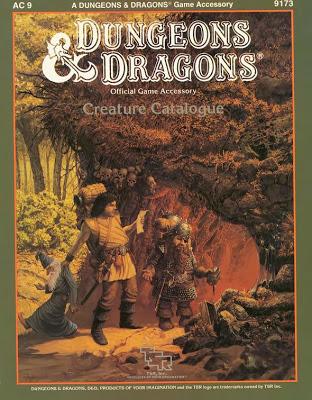
Creature Catalogue for Dungeons & Dragons (BECMI) by TSR, 1986; 63 pages of monsters.
Remember the Juggernaut from the 3rd ed. MM2? Some kind of massive tank/siege-tower golem on wheels? That one is in this book too. However, old fans of the game have told me that it really only appeared in a single adventure and was never used or mentioned anywhere else. Not sure what is the greater mystery: Why they put it into the CC in the first place, or why they later thought it was one of the best things in the book that needs to go into the MM2?
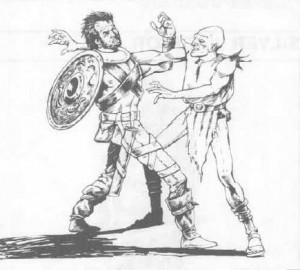
The Magen (majen?) looks like an ordinary human, but is indeed a magical and alchemical creation. As magical constructs they need no sleep, food, water, or even air to survive and they do not age either. While not great thinkers, they are amazingly intelligent for constructs and can function among humans without supervision by their master without any problems. Though they are not particularly powerful creatures, at least compared to golems, this makes them extremely useful and valuable. There are four different types of magen, which each have their own unique powers. The hypnos is using a permanent charm effect which should make them absolutely perfect for spying or kidnapping. All they have to do is ask and most guards and officials will be perfectly fine with doing anything asked of them. The demos is made for combat and can use use all weapons and armor. It usually is encountered in groups up to a dozen. A caldron can stretch its limbs to lengths of 6 meters and uses them to hold victims and kill them with acid that comes from their skin. The galvan is the strongest type and can use weapons and shot three lightning bolts per day. Magen are very expensive and difficult to make, so they are quite rare. When they are killed, the magic that animates them ends and they crumble into ash with a flash of flame, which might be the first indication that the PCs are not dealing with ordinary humans at all. The first idea I got was to use them as guards in some wizards castle that the PCs are supposed to quietly sneak into and then see how far they will have made it into the catacombs before they realize that none of the guards and servants they’ve sneaked past are humans but something entirely else and unnatural. I am sure there’s a lot of other cool things that could be done with them.
Also, remember the Belker? It’s in the 3rd ed. Monster Manual. That evil cloud of smoke that attacks with two clawed hands. Another really lame thing that also comes from the Creature Catalogue. Should have stayed there.
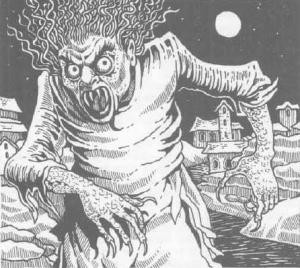
The Bhut is a kind of undead creature that looks like a living person but turns into a ghoulish corpse during the night and can not be detected by spells that identify evil and undead creatures. They can also not be turned by a cleric as almost all other undead can. They can only be harmed by magic weapons and are very intelligent, which makes them extremely dangerous when they are hunting for living people to eat. Like ghouls, their bite causes paralysis and can move in total silence. They are quite strong and to make things worse usually appear in groups. I think these creatures can make for quite interesting mystery adventures and be pretty terrifying when finally revealed.
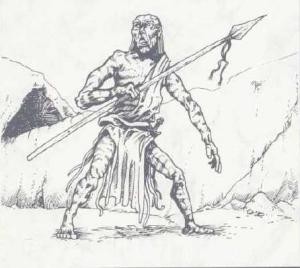
A Chameleon Man is a tall and thin humanoid with multicolored skin, which probably is the reason for their name. However, it doesn’t actually have the ability to change their color, but instead possess the ability to instantly teleport over a distance of 40 meters, suddenly appearing and disappearing without a trace. It cannot attack in the same round it teleports, but usually attacks in groups for that very reason. They are not individually powerful, but could get really frustrating to fight.
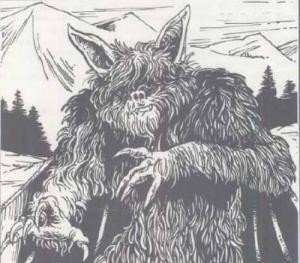
Usually I go for interesting creatures, but the Cryion is so weird that it needs to be mentioned here. Cryions are a race of large humanoid bats with thick fur that live in the frozen lands in the north. They can’t actually fly but instead use their wings as sails as they skate on the frozen sea and rivers with the claws on their feet. They also have large sleds with sails which they use to carry their tends and supplies as they travel the frozen wastelands. Every three years all the clans will come together to form into large hordes of several hundred and journey south to obtain things they need like weapons and tools. Sometimes they trade, at other times they come skating down the frozen rivers to raid and then skate back to their arctic homeland again. The default Basic setting is just weird like that. I am sure we’re going to see a lot more of this kind later on.
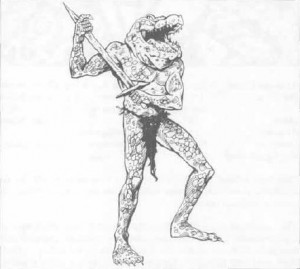
A Gator Man is basically just a beefed up lizard man with the head of an alligator instead of a lizard. In actual combat, they are a lot meaner, though. Gator men stand well over 2 meters tall and at 7 Hit Dice really have a lot of hit points and good chances to hit which are well beyond what you usually get from humanoid monsters. They also swim 50% faster than human characters run, which can make them very mean ambushers. They attack with normal weapons, but these completely pale compared to their bite, which deals a massive 3d6 damage. Groups of them are usually lead by a chief, who is even bigger and meaner and has a bite that deals 4d6 damage. When encountered by low level characters, they probably simply bite their head off!
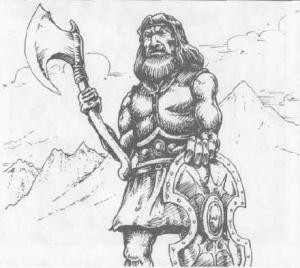
A Hephaeston is a giant for high level adventures. It’s 8 meters tall and has intimidating 25 Hit Dice, which should be well over 100 hit points. The skin of a hephaeston is like iron and gives him a very high armor class and can only be injured by magical weapons. It is completely immune to mind affecting magic, all spells of 1st and 2nd level, and fire. Though I think by the time a group of player characters has any chance to fight this guy, they probably wouldn’t attempt to hurt him with nonmagical weapons and low-level spells anyway. The amount of damage it can dish out is staggering. When attacking with a weapon, it deals 4d10 points of damage and it also has the option to attack with a free hand as well, which also deals impressive 3d10 points of damage. If that bitch slap from hell hits with an 18 or higher, the hephaeston grabs the character and smashes him into the ground for another 5d6 damage. This is so funny I wonder if anyone would ever make make a hephaeston fight with a shield. In addition, it also has the ability to levitate iron objects (to throw on people, I assume), make an iron object get red hot, or magically create a wall of solid iron. Fighting one of these guys really doesn’t sound fun. Or very fun, depending on how you look at it. Fortunately, hephaestons live alone.
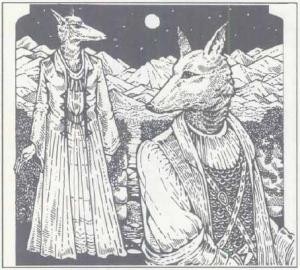
The Hutaakans are probably one of the most iconic creatures of the Known World. Which means that most of you have probably never heard of them. Hutaakans are humanoids with jackal-like heads but are otherwise very similar to humans or elves. In the ancient past, they ruled over a small empire but have almost disappeared by now, with only a few groups remaining in remote mountain cities. They are not particularly strong and have no real special abilities other than being able to see in the dark and being quite sneaky. They are highly civilized and ruled by a caste of priests. Overall, they are really very similar to stereotypical elves with dog heads and priests instead of wizards. It’s mostly their place in the Known World setting that makes them popular, but as generic monster for games in other worlds there really isn’t anything remarkable about them.
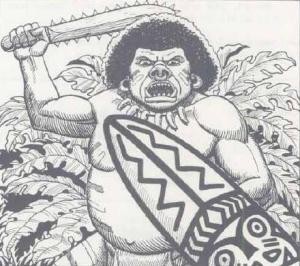
The Kara-kara are a race of humanoids who live on the islands in the south of the Known World and are basically chubby Polynesian orcs. They don’t have any metal weapons or armor, but can prepare themselves for battle with a war dance that makes them tougher and more resistance to spells. Or as the great Mystara scholar Blacky the Blackball called them, “racist as fuck”. I personally don’t quite see the problem since the are orc with a new stylistic design, but perhaps it’s a British thing. I don’t know what popular racist stereotypes there are still floating around and have not been fully dealt with in Britain.
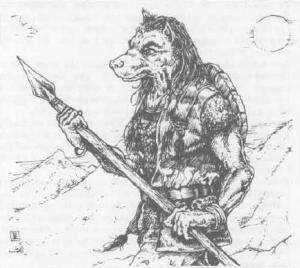
Lupins are like werewolves but good instead of evil. They hate werewolves a lot and will ally with humans to hunt and destroy them. Which to me very much sounds like some player has been whining to his GM that he want’s to play a werewolf and it totally won’t be disrupting the party, really. On the plus side, they are often riding dire wolves and attacking with lances, which does indeed sound pretty cool.
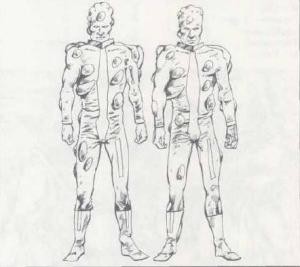
The Oards are typical BECMI weirdness. The module in which they originally appeared in can be summed up as “A group of cybernetic creatures from the future have traveled back through time to enslave the human race… and you’re here to stop them?” Which is a quote from Star Trek 8, which has exactly the same plot. Predating the Borg from Star Trek by four years, I just can’t see how the costume designers came up with the alien design independently, without having been aware of the oards. And it’s not just the suits. Oards are grown in breeding tanks and then having large parts of their bodies replaced with machinery. (Assimilation was only introduced in Star Trek one season after the first appearance of the Borg and later retconned.) They lack any real individuality and all wear the same dark grey suits. They are immune to all illusions and paralyzation and have very high saving throws. They have all kinds of technological devices that allow them to shot projectiles like magic missiles from their hands or create a forcefield that works like protection from normal missles, resist cold, and resist fire. People can complain all they want about coincidences, cybermen, and terminator, but these are Borg! Four years before Star Trek. And it’s not mentioned on either wikipedia or the Star Trek wiki. Plagiarism, I shout. Plagiarism! But the result was cool, so I am okay with that. The oards also have a few special abilities that the Borg don’t have, like holographic image projectors that can make them look like normal people and the ability to levitate.
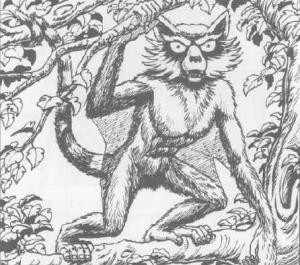
The Phanaton is described as a creature that looks like a cross between a racoon and a monkey and also a flying squirrel. They are about as big as halflings and only slightly less intelligent than most humanoids. They build their villages in the branches of large trees and as lawful creatures are usually friendly to most adventurers. They are also friends of elves, treants, and dryads. A normal phanaton is pretty weak and have only 3 hit points on average, but a village is usually led by a king with 8 HD and 50 hp who also has a bodyguard of warriors with 6 HD and 30 hp, which can easily be much tougher and stronger than players would expect.
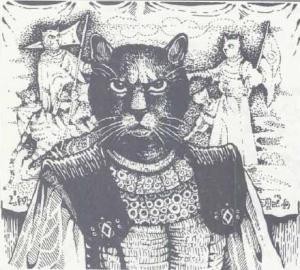
Rakasta: All I have to say it Khajiit has wares, if you have coin.
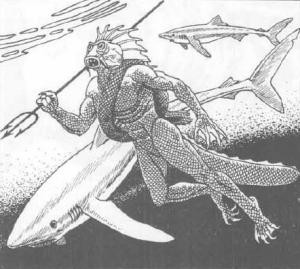
Shark-kin seem very similar to sahuagin but with a few unusual differences. In their normal form, shark-kin are unable to walk or survive outside of water and their alignment is neutral. However, any time the king of a tribe dies the legs of the shark-kin grow stronger and they become able to breath air and they come to land for a ritual to select a new leader. During those times they are extremely hostile and aggressive, seemingly behaving just the same way as sahuagin do.
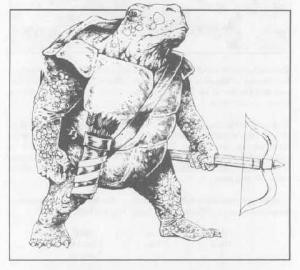
Tortles are weird, and I am having the clear impression that their entry here falls very much short of what’s the actual deal behind them. They are humanoid turtles who can hold their breath for well over an hour and retreat into their shell for protection. Which for a creature with this large limbs and such a small shell clearly doesn’t work and wouldn’t be much protection at all, since the opening are so big that pretty much anything that might be of danger to a turtle can reach inside them with claws or weapons, hurting the immobile tortle anyway. They also prefer to fight with light crossbows, for reasons that are not given here. The most interesting part is that they have very high morale, pretty decent intelligence, and are also Lawful, which makes them more likely to be allies than enemies.
I mention Tritons here in brief for the Hall of Shame. Because, as I quote, “Tritons look very much like mermen, having a humanoid torso and fish-like tails. The only differences are cultural and their innate ability to cast spells.” So they are merman clerics. That’s not a new creature.
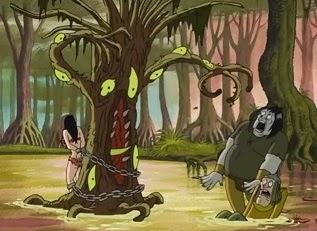
Hey, it’s the Killer Tree from Korgoth! It’s arms have a reach of 6 meters and don’t deal any damage, but will grab a victim into its mouth, where it takes 3d6 points of damage until either of them is dead.
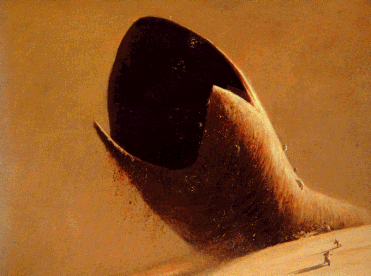
The game calls it a Desert Leviathan, but it’s a sandworm. If you rip off sandworms, call them sandworms.
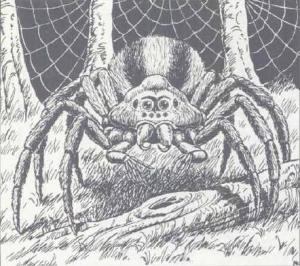
The Aranea is a large intelligent spider with humanlike arms to the sides of it’s head. It’s a original creature from the Known World and though it had made it into the 3rd edition Monster Manual it didn’t see a lot of use outside of the setting to my knowledge. The arenea presented here is quite different from the one in the Monster Manual. It is highly intelligent and can cast spells like a 3rd level magic user, but it does not have any ability to shapechange into either a human or hybrid form. It also does look a lot more like a full spider and has no other humanlike feature except its arms. Interestingly its alignment is also Chaotic, which makes it basically evil in the 3rd edition alignment system.

A Baldandar is a creature similar to doppelgangers. However, they are not shapechangers but masters of illusion instead. They can create almost any illusion imaginable in a radius of 80 meters and their illusions will remain for 10 minutes after they stop directly controlling them. Their illusions are not simply deceptions of the senses but are partly real. A baldandar can even cast illusions of other spells, but creatures targeted by them can make a saving throw at a -4 penalty to recognize that they are fake and be unaffected. It also can make itself invisible and fly around at will, which makes them very difficult to catch or corner.
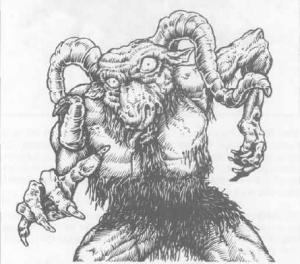
The Bargda is a creature related to ogres and trolls and usually found as the leader of a group of these monsters. In addition to their great strength and toughness, they are so horribly hideous that anyone who sees them must make a saving throw or suffer a penalty to attacks and damage. In addition to attacking with a huge club, a bargda can also bite, which transmits a disease that reduces the victims dexterity.
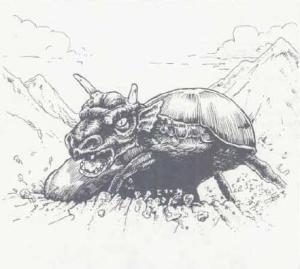
The Earthquake Beetle seems like a creature that was regarded as too silly for the Fiend Folio. But too silly for the Fiend Folio does not mean too silly for the Known World. It’s a giant beetle with a dragons head and massive 40 hit dice. It moves by burrowing underground and when it approaches it causes an earthquake identical to the effect of an earthquake spell cast by a 25th level cleric. Having a dragon head, it also has a breath weapon, which it can use once per week. Wow.
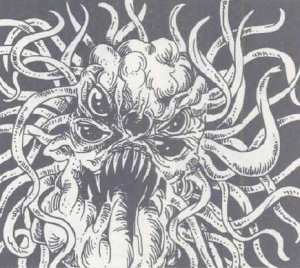
While the earthquake beetle is stupid, the Brain Collector is just some really weirdass shit. It easily out-weirds beholders, illithids, and flumphs any day. They are big, writhing and bulging creatures with a huge maw full of teeth, lots of tentacles, and way too many eyes. When these creatures from another strange dimension come into this world, they kill humanoids, remove their brains, and add them to their own, which causes all those bulges on its head. With each one it gains the ability to cast more spells.
A Dragonfly is a a half-dragon insect. Yes, nothing is too dumb for the Known World.
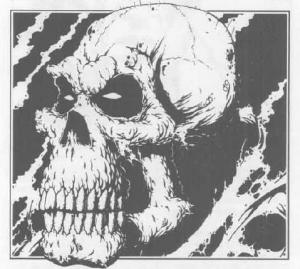
The Dusanu looks like a rotting skeleton dressed in a ragged cloak and covered in mold, but apparently is not undead, given its position in this chapter of the book. It’s also called a rot fiend, but is not a demon either. A dusanu is very intelligent and attacks with its claws, but it’s main ability is a cloud of spores that constantly surround it. Anyone who gets too close to it becomes infected with the spores and unable to heal wounds with magic spells and dies after a few days to become one of these creatures himself unless the disease is magically cured. Still, Skeleton with a Robe: +1.
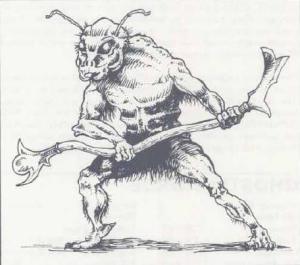
The Hivebrood is a swarm of insects that reproduces by putting larvas into humanoid bodies which then grow to turn the person into one of them. They are all controlled by a hivemother. Maybe back in the early 80s that concept was still original. But probably not. The most interesting ability they have is that the broodmother is able to turn larvas into a more powerful form than normal drones to become hiveminds. Hiveminds have the interesting ability that they can gain any ability from any creature they eat, which includes any spells memorized by spellcasters they consumed. When in danger, a hivemind can release a chemical cloud that spreads through the hive and shares a single ability with all the regular drones for three rounds, after which it is lost. If that ability is something like casting fireball, the result can be utterly devastating for the PCs.
The Ice Wolf is simply a different name for the well known winter wolf and has exactly the same abilities. (Demon Dogs +1)
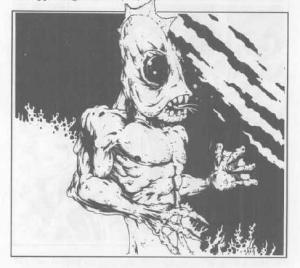
The Kopru is a classic monsters from X1 The Isle of Dread. It’s fame is mostly tied to that classic adventure. They have three tails which they use to grab enemies and have a special power to control the mind of any creature and have full access to it. I did some snooping around if the kopru predates aboleths that are surprisingly similar, and it turns out they both appeared in the same year. And in addition, The Isle of Dread and Dwellers of the Forbidden City were both written by Zeb Cook. So yeah, they are basically the same idea slightly modified for B/X and AD&D. This is the same Cook that did the “Cook Expert” set of the “Moldvay/Cook” edition and also the Kara-Tur and Planescape settings. Why isn’t he more famous? He’s probably the second most influential person to make D&D into what we know now. Aboleths are a lot cooler than kopru, though.
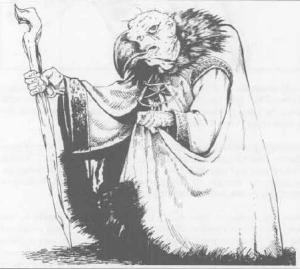
The Nagpa is from the adventure X4 Master of the Desert Nomads, which is one of my favorite ones. And also made by Zeb Cook. Not as cool as the Bhut but better than the Juggernaut from the same adventure. They are humanoids with vulture heads and various magical powers like making objects within 20 meters to burst into flames or decay, paralyse all lawful characters within 3 meters, and cast darkness and illusions. It took about 30 years until designers realized that just four or five spell abilities are enough for an interesting encounter and you don’t need a spellcasting monster to have as many spells as a high level wizard.
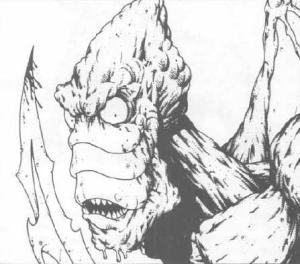
Sabreclaws are winged humanoid creatures who are encountered in groups of up to 20. Individually they are in the lower middle range as monster strength goes, but they have the unique ability that all members of the group pool their hit points together and as long as any remain, the entire group will stay alive. Once the group has been dealt sufficient injuries, they all die at once, even individuals that have not been yet at all. They also are immune to spells of 1st to 3rd level and have saving throws like 25th level fighters. They have only 5 Hit Dice and are very dumb, but in large numbers they will extremely difficult to defeat as they can just fly away when they start to get severely injured. Swarms can consists of multiple linked groups and parties might face up to a hundred of them, which probably are a quite serious challenge even for relatively high level characters.
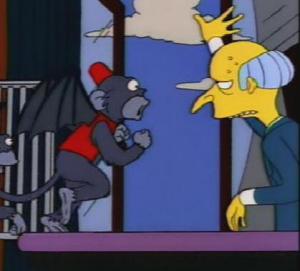
Tabi are small winged apes with venomous claws. Anyone poisoned by them will start to randomly fight anyone nearby and the venom can last for a full hour or two until its effect ends. Wizards can get a tabi as a familiar. I think they are from some American children’s book. (Evil Apes +1)
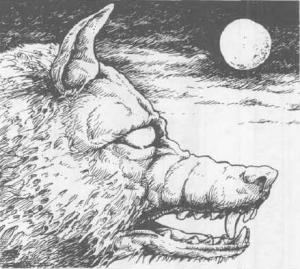
Yowlers are the yeth hounds from Planescape and D&D 3rd edition. They are large dogs with somewhat human-like faces and pointed ears that look like demonic horns. They are not particularly strong individually, but usually appear in groups and can fly through the air at great speeds. They come out only at night to hunt and prefer elves, dwarves, and halflings as prey. I think Planescape changed that to fey and fey-like angelic creatures, which I really like as it gives the players something to do when in the realms of the fey. Yowlers have a terrifying howl which causes anyone within 30 meters to flee in panic and the difficulty to resist it increases with the number of yowlers howling. They can only be harmed by silver or magical weapons and even then they take only very little damage. (Demon Dogs +1)
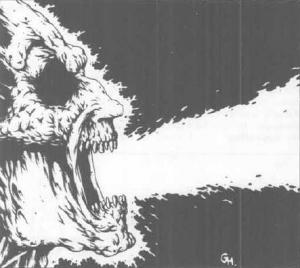
An Agarat looks just like a ghoul, but instead of paralyzing a living creature with its touch it has a scream that temporarily makes any nearby creatures lose one character level. The level returns after about half an hour and each agarat can only scream once in every encounter, but multiple agarats can take down even higher level characters that way. If all levels are lost, creatures fall unconscious for a hour or two and then awaken unless they have been eaten. (Variant Ghouls +1)
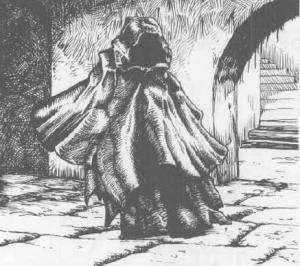
The Dark-hood is a ghost that can only be harmed by greatly enchanted weapons and is very difficult to turn by a cleric. It attacks by creating visions of things created by the minds of their victims, so the people with the highest Intelligence scores are affected the worst. They gain some kind of sustenance from chasing people around in panic and each round a character runs from a dark-hood he temporarily loses 1d3 points of Constitution on a failed saving throw until he collapses from exhaustion. Though they can harm with their touch, they usually leave people alone once they have chased them through their lair for a while.
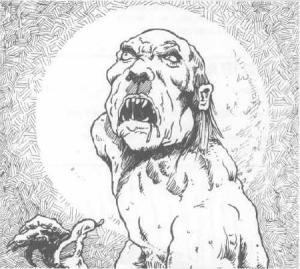
An Elder Ghoul is a slightly stronger kind of ghoul with only one special ability. When attacked it becomes surrounded by a green glow that increases 5 feet in diameter every round and makes all enemies within it have slightly reduced chances to hit and damage. Meh. (Variant Ghouls +1)
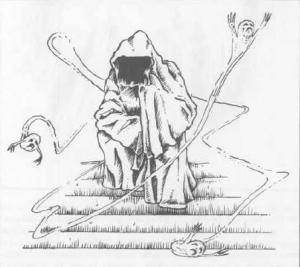
A Grey Philosopher is created when a chaotic cleric dies while his mind is occupied with a problem of great significance. In undeath, the ghost will simply sit on a bench and chair and continue its ponderings and nothing can break its concentrations. Over many centuries, some of the grey philosophers evil thoughts take on a mind of their own and constantly swarm around it. These evil thoughts are the only real danger that comes from the ghost and can either be destroyed individually or vanish when the philosopher is killed. They have pretty high hit rolls and are difficult to hit with weapons or spells but don’t do a lot of damage and have only very few hp. As the small ghost can move up to 30 meters away from the philosopher, it might not be immediately obvious where they come from and the main creature might be difficult to find if it sits in a dark corner or small storeroom. Since a grey philosopher does not actually do anything, they probably can’t be really used as the centerpiece of an adventure, but I think they probably could make a very interesting addition to larger ruins the PCs are visiting for a completely unconnected reason. They are more an interesting environment feature than a real enemy. I can perfectly imagine one of them sitting in some hidden corner in Dark Souls.
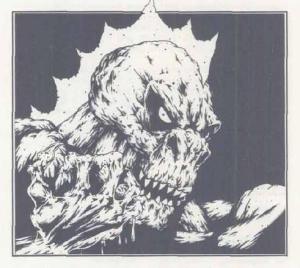
The Mesmer seems like a rip-off of the morkoth, which seems very weird since this game is also D&D and could just the morkoth as it is. It lives in a labyrinth of tunnels in the ocean floor that has hypnotic confusing effects on any who enter it. In the center sits the creature awaiting its prey. For some reason the mesmer is undead, while the morkoth is not, but that seems to be the only difference. There is no information how the mesmer looks like and how it comes into being. Weird.
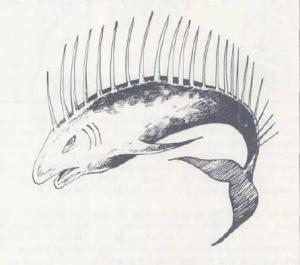
The Phygorax is fascinating, being an undead fish. The spines on its back drain life energy, but it can not use them to attack. Instead it creates illusions that trick other creatures into touching it. Any creature that dies from this energy drain transforms into a phygorax itself. I wonder if the name is actually a Greek word that has a meaning or just some cool sounding letters.
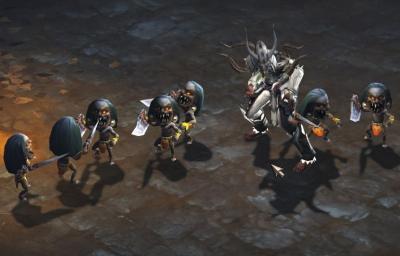
Topis are creatures similar to ghouls that are created from human bodies that were shrunk down to tiny size by primitive witch doctors. They are surprisingly fast and can jump longer distances than expected for such small creatures and hits by their claws have an effect like the slow spell. Hitting them with maces and hammers deals only half damage but knocks them to the ground. (Variant Ghouls +1)
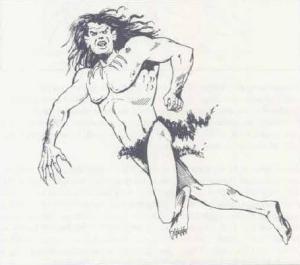
D&D has aquatic ogres (merrows), aquatic trolls (scrags), aquatic ghouls (lacedons), and aquatic umber hulks (vodyanoi). The Velya is the aquatic vampire. Most velyas were aquatic humanoids in life, such as mermen or aquatic elves and appear like blue skinned humans. They can turn into a shark or manta ray instead of a wolf or a bat, and when defeated they turn into liquid instead of mist and return to their lair. They can summon a swarm of small sharks instead of bats and they magically charm people by singing. Otherwise they are identical to normal vampires.
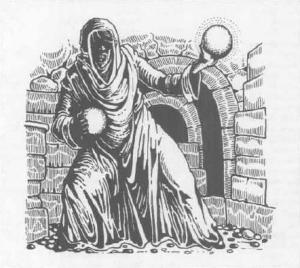
A Wyrd is an undead elf from the Known World setting. They appear like elven corpses wearing dark hooded robes. (Why? Just because!) They attack in a rather strange manner as they are always holding two glowing spheres of light in their hands which they either use to hit their enemies or throw them at them. When they do, new spheres immediately appear in their empty hands. Greater wyrds are much more powerful, having the ability to fly and hits by their spheres cause paralysis. I am pretty sure their is a story reason behind the spheres in the original adventure they appeared in, but with no further explanation given in this book it seems rather odd. (Skeletons with Robes +1)
Creature Collection Cliche Creature Counter:
- Evil Apes: 1
- Variant Ghouls: 3
- Demon Dogs: 3
- Skeletons with Robes: 2
The following creatures are from several other books for the same edition of Dungeons & Dragons as the Creature Collection. Since there are so few of them, I included them on this page here.
Basic Set
Oh, right off to a good start: BECMI can rightfully be considered the Dad Joke edition of Dungeons & Dragons. Some people on the time really had a great fondness for them. The largest of the giant spiders in the Basic Set is the Tarantella. Maybe you are like me and think “Don’t you mean tarantula? Isn’t tarantella some kind of dance?” And yes, it is. The tarantella is a giant tarantula that has a special poison that does not kill but instead causes the victim to start dancing. It’s a magical poison and everyone who sees a poisoned person dancing must make a saving throw or also start to dance. After about an hour of dancing, they will collapse from exhaustion. *groan*
According to legend, the Thoul was inspired by a typo. The creature that was made from it is a magical crossbreed of a troll, a ghoul, and a hobgoblin. A thoul looks almost exactly like a hobgoblin, but has a paralyzing touch like a ghoul and regenrates 1 hit point every round like a troll. They are not terribly strong, but for 1st and 2nd level characters they might actually be quite mean and a lot more challenging than a regular hobgoblin. Nice boss for a 1st level dungeon crawl, I would say.
Expert Set
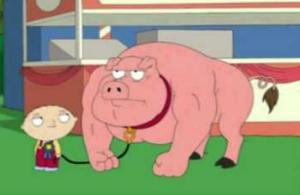
The Devil Swine is a special type of lycanthrope. It can change shape freely during the night, but stays in whichever form it had last taken during the day. It prefers to eat human flesh and at 9 HD is a really mean beast, much more dangerous than even werebears or weretigers. As a special ability, a devil swine can cast charm person three times per day and often is accompanied by a few human minions. Lawrence Schick confirmed to me that the devil swine is indeed based on the swine things from the novel The House on the Borderland which he and Tom Moldvay quite loved. And whose title should also sound quite familiar to long time D&D fans.
Not a new monster, but I think it’s interesting that the types of giants in the Expert Set are the same ones as in the 3rd Edition Monster Manual, while the Monstrous Manual of AD&D, on which the 3rd edition is primarily based, has a lot more varieties that never really made much of an appearance in the later editions.
The golems in the Expert Set are very different, though. None of the “classic” types are found here, instead we get two unusual and two unqiue variants. Wood golems and bone golems have shown up in many other places, while the bronze golem is a lesser variant of iron golems. The most unique of the four is the amber golem, which has the shape of a huge lion or tiger and can track any targets and even see invisible creatures. This one really could have been used a lot more.
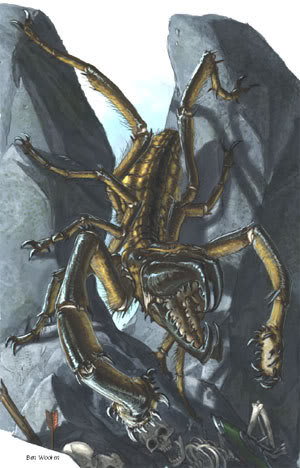
The Rhagodessa is something I’ve never heard of before now. The description is not very helpful and there is no picture in the Expert Set. However, it made an appearance in the Savage Tide adventure path from the Dungeon magazine, which takes largely place on the Isle of Dread from the Expert adventure module X1 The Isle of Dread, which was included in this version of the Expert Set. That’s where I got the picture from. The rhagodessa is a huge spider-like monster the size of a horse. They attack with their front legs, which do no damage, but keep the target in place to bite it with its massive jaws. Rhagodessas also only hunt in the dark. Hooray!
Rules Cyclopedia
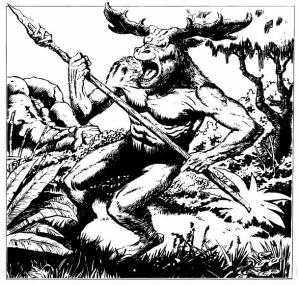
The Actaeon is a powerful protector of the forest. It appears like a humanoid giant with the head of an elk and is very strong and tough. Actaeons attack those who cause significant destruction to their forests and have the ability to summon other powerful creatures of the woods like bears, griffons, and treants. They also have a breath weapon that can turn enemies into harmless small forest critters forever. Even if they make their save they are transformed for 24 hours, which makes this ability extremely powerful. They also can make themselves invisible and are respected as leaders of the fey that inhabit their forest. They really remind me a lot of the demigod Cenarius from Warcraft III.
Snow Apes are somewhat intelligent Chaotic apes who eat almost anything, uncluding humans. They are very strong and almost invisible in snowy environment. (Evil Apes +1)
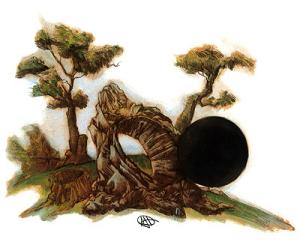
The Blackball is one of the really cool monsters of BECMI, though it hardly even qualifies as a creature. It’s a sphere of completely blackness one and a half meters in diameter, similar to a sphere of annihilation, that slowly drifts around aimlessly, disintegrating anything it comes into contact with. It has no mind or awareness, but when a creature comes within 20 meters, it will slowly start to drift in its direction and following it around until it comes into contact with it, or the creature moves outside that range. Since its relatively slow, it can be easily outrun in most situations, even underground and inside buildings. However, if one is found blocking a passage the players want to cross it can be quite a challenge to carefully draw it away without getting disintegrated. And they might suddenly pop out of a wall or approach unnoticed during a fight with other creatures.
Devilfish are a race of chaotic manta ray clerics. They also exist in AD&D, where they have a name that is both unpronounceable and unspellable, so I am really in favor of calling them devilfish. There also is a vampire devilfish variant. Devilfish leaders can be very powerful as clerics of 16th level. But then, this is the Known World where 30th level NPCs are not exactly rare. I always considered these both odd and also quite cool creatures. From what I now know about the Known World, it really doesn’t surprise me at all to find them here, and they probably first appeared in that setting.
A dragon shaped golem is called a Drolem. How creative. Stupid Pun Monsters +1?
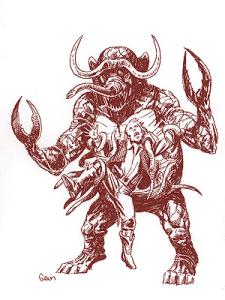
This image shows a Malfera. It’s some kind of demon from the Dimension of Nightmares, but other than the description what it looks like we’re only told that it can see invisible creatures and has a poisonous breath. It probably made sense in the adventure it appeared in.
